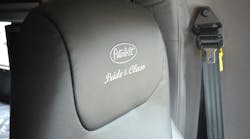From the spotless floor of its North Texas assembly facility to evaluating multiple designs for a part as seemingly routine as a hood latch, members of the Peterbilt team were emphatic: To be a premium brand—to back up the “Class Pays” tagline that accompanies the iconic red oval—means every detail counts.
That’s the takeaway from a visit to Denton last week where trucking journalists were treated to an inside look at the development of a Peterbilt truck from the drawing board to prototyping to production to the customer.
As Design Manager Phil Hall explained in a visit to the Engineering Lab, the four key stages in his shop are “discover, design, develop, deliver.” And the key is the “qualitative research” that goes into the product. But he’s not talking about the latest fluid-dynamics calculations; he’s talking about the truck driver.
“We really want to understand our drivers, all the way down to what they do every day, how they feel about their trucks, their emotions, to what their dreams and aspirations are,” Hall said. “When we get that kind of information, we develop insights from it.”
He shows a display of a dozen sketches of the early ideas for the Model 579 (sorry, photos were not allowed in the studio or in the plant) and explains that these are just a representative sample of the “wall full” of ideas—“hundreds and possibly thousands of sketches”—that the design team generates in trying to capture that feel the driver wants.Designers also make the rounds of the engineering and manufacturing departments and conduct customer reviews as the designs are narrowed and evaluated.
“That’s our job as designers: It’s not just creating a product, a vehicle that goes down the road—but creating a vehicle that makes that connection with the driver,” Hall said.
Indeed, Peterbilt was the only truck manufacturer with an entry in the Los Angeles Auto Show Design Challenge last fall, themed “Sensing the Future: How will vehicles interact with us in 2029?”
Peterbilt’s vision is one in which vehicles will operate together in “truly symbiotic relationships,” and truck drivers will become “highway pilots” and will lead groups of vehicles, taking responsibility for passengers as well as cargo. The SymbiotUX concept explores this human-machine interface, as Hall explains.
(A gallery of a mind-blowing look at the future of the road, and a detailed explanation of how the concept makes sense, is here.)
“Imagine what a steering wheel will look like 20 years from now. Will it even exist?” he says. “There are no restrictions on these advanced concepts.”
The point isn’t to just play around with wild ideas, however—it’s to be ready for the future, and to help set the course.
Meanwhile, back in the present, Hall advances the Model 579 design from sketches and CAD images to the clay model phase, which provides a much better look at the real world shape, the vehicle’s contours and shadows. And any resulting changes in the shape are the captured by a special camera system and fed back as new 3D data.
Also impressive, perhaps even most impressive, is the design team’s focus on anything and everything that a driver might see or touch or hear.
Hall displayed various iterations the Model 579 EPIC badge, as produced on one of the facility’s 3D printers. He then showed different versions of a simple black hood latch, to better assess whether the part should be logoed or not. Also on hand was a thick binder filled with various fabric swatches the team used to select interior options, again all part of what gives a truck a Peterbilt personality.
“The truck has to be functional, but it has to be beautiful as well,” Hall said.
While the Engineering Lab excites the imagination, the real work at the Denton facility was next door at the 450,000 square-foot assembly building.
Surprisingly bright, quiet, and climate controlled, 81 trucks roll off the line in each of two shifts. That’s up from just 15 trucks a shift in the not too distant past, as tour host Salty Rose explained.
Much of that increase in productivity comes from an increased use of robotics but, Rose said, workers aren’t replaced. Instead, they shift to duties where a human touch is essential.
Indeed, on the plant walk-around, Rose routinely calls out the names of workers and their duties. He knows how many years most have worked there, and he even knows the employee numbers of a couple.
Rose also emphasized the importance of the facility to North Texas, not only as a source of good jobs but as a community leader.
Clearly, the assembly floor is where the workforce gives the company’s trucks their original coat of Peterbilt “pride.”





